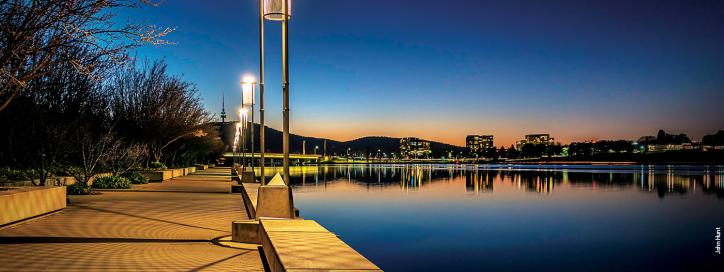Outdoor Lighting Policy - Part Four: Environment and sustainability

Light pollution
Light pollution is the introduction by humans, directly or indirectly, of artificial light into the environment. Some common forms of light pollution are:
- Light trespass or spill is artificial light that is projected into areas where it is not wanted. For instance, light trespass or spill can be observed in residential areas where street or path lighting is directed into houses, affecting peoples' sleep patterns, or in areas where wildlife may be impacted. Light spill can be a nuisance to residents and affect the legibility of the city at night.It can include forms such as traffic lights, vehicle headlights, internal building lights and signs.
- Light clutter is a condition where the concentration of multiple light fittings within a given area is too great, resulting in inconsistent and/or excessive illumination conditions. This can be observed in cases where the number and design of light fittings in an area have gradually been added to over time.
- Over-illumination is the provision of artificial light in excess of the required level for the intended application. The use of light sources that exceed the design requirements in their illuminance or intensity is a cause of over-illumination by not taking account of ambient light levels produced by existing light fittings or internal building illumination.
- Sky glow is upward wasted light caused by excessive illumination, light being directed upwards or light being reflected into the sky from light-coloured or reflective surfaces. This reduces the visibility of the night sky in urban areas, which as a consequence can affect astronomy, aircraft navigation and air quality.
Energy use
The main factors that determine the amount of energy used by lighting systems are the overall design of the system, the lamp type, light fitting, the controller (or driver) and the duration and intensity of its operation. The age and condition of existing light fittings can also contribute to increased energy use and operating costs. The amount of energy that goes into establishing, maintaining and replacing lighting infrastructure is a major factor in the overall energy use and cost of operating lighting systems.
Energy waste
In cases where artificial light is provided at a time or in a place that is not needed, the energy is wasted. For instance, the operation of outdoor lighting at full intensity for the duration of the night may be unnecessary, given the reduced level of pedestrian and vehicular activity between the hours of midnight and 5:00am. Most forms of light pollution including upward light spill and light trespass are examples of energy waste.
Urban ecology
The way that lighting is designed and operated can affect our natural environment in a number of ways. Lighting can affect the navigation, migration, sleep and predatory behaviour of animals, birds and insects.
The installation and maintenance of lighting infrastructure such as poles and cabling can directly impact tree health through limb and root pruning works.
Night sky visibility
Our visual connection with the night sky makes an important contribution to our knowledge, heritage and culture. It is important that future generations have the opportunity to see and understand the night sky, which can be impeded by lighting design and operation.
Objectives
Policy Objective 4: Minimise the obtrusive effects of artificial lighting on the environment.
Strategies and requirements
Strategy 4a) Manage light pollution through the selection and placement of lighting hardware.
Design requirements:
- Use full cut-off light fittings, lens diffusers, or light sources that provide indirect or reflected light (unless otherwise noted in this policy).
- Select optical systems and shielding designs for artificial light sources that effectively manage glare and light distribution behind and above the light source.
- Install and operate lighting only where it responds to a demonstrated need or requirement. Consider the removal of lighting where it does not fit this criteria.
- Co-ordinate the removal or replacement of existing light fittings in proximity to any proposed lighting works to reduce variances in lighting hardware and effect.
- Minimise the distribution of artificial light beyond the intended area to be lit.
Strategy 4b) Minimise energy use.
Design Requirements:
- Select lighting hardware components that offer a long service life, feature an enduring aesthetic appeal, be of a high quality construction and offer reliable, low maintenance performance.
- Consider energy use and value for money in any lighting upgrade or new installation.
- Install efficient lighting control systems that can adjust illumination to suit activity levels, saving energy whilst maintaining safety when required.
- Use co-ordinated lighting management systems to reduce energy and maintenance and improve uniformity and safety.
Strategy 4c) Ensure the installation and maintenance of lighting infrastructure does not have a detrimental effect on landscape.
Design requirements:
- Design light poles and outreach arms around the long-term form of trees to maintain light performance and minimise tree maintenance.
- Locate light poles and power cables around established tree and root locations.
Strategy 4d) Minimise the impact of lighting operation on wildlife health.
Design requirements:
- Use full cut-off light fittings within landscape areas to reduce impact on wildlife.
- Reduce the intensity or turn off lighting at times it is not needed in landscape areas, to reduce impact on wildlife.
- Reduce the intensity and duration of external building lighting operation during migration periods of the Bogong moth in October and between February and April. Shut off lights that are not needed during the second half of the night at times of peak moth migration.
- Ensure that the design and operation of lighting does not cause wildlife or avifauna disorientation, injury or death.
